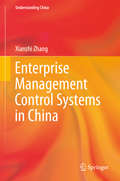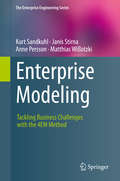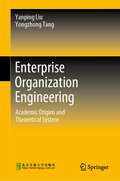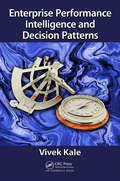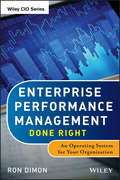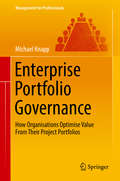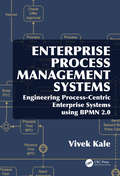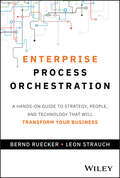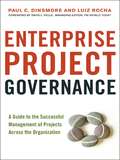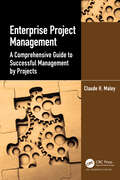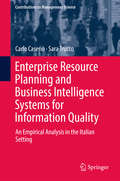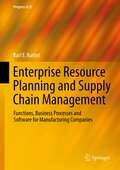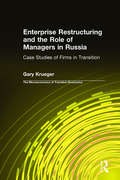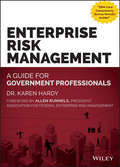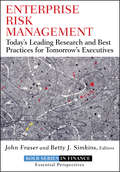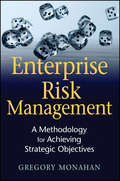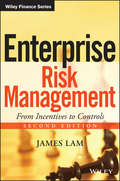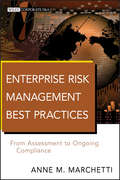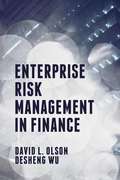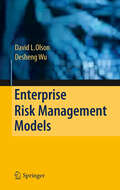- Table View
- List View
Enterprise Management Control Systems in China
by Xianzhi ZhangThis book provides an exhaustive view of China's Management Control Systems (MCS), examining the development of theory and practice and presenting a framework that integrates China's unique enterprise regulations, corporate culture and managerial mindset into management control systems. The work offers detail about the effects of China's economic reforms on management control in Chinese enterprises and insightful comparisons with Western theory and Western examples. Readers will discover important themes and the evolution of theory in MCS, including discussions of frameworks and the links between management control and economics, management, accounting, cybernetics and system theory. Early chapters explore management control in Chinese enterprises during the period, especially the demands of (guidance, enforcement and external regulation) and the demand for (stakeholders, managers, investors) management control. The work moves on to explore Western management control theory and research, including an examination of the evolution of internal control theory. The author presents detailed perspectives on the elements of management control systems and introduces masterful new ideas and methods through four general control models and ten critical elements in the management control process. A view of management control in various different types of enterprise is presented, from special enterprises and small to medium enterprises to non-profit organizations. The standards for enterprise management control are explored. This work is a valuable practical guide for corporate management teams who wish to develop and execute their own internal control strategies. It will also provide foreign researchers, policy-makers and practitioners with a new perspective on Chinese management control experiences
Enterprise Modeling
by Kurt Sandkuhl Matthias Wißotzki Janis Stirna Anne PerssonEnterprise modeling (EM) methods and techniques are indispensable for understanding the present situation of an enterprise and for preparing for its future - particularly in times of continuous organizational change, an increasing pace of innovation, new market challenges or technology advances. The authors combine a detailed description of the 4EM methodology with their concrete experience gathered in projects. Their book addresses the modeling procedure, modeling language and modeling practices in a uniquely integrated approach. It provides practical advice on common challenges faced by enterprises and offers a flexible EM method suitable for tackling those challenges. Much of the work presented stems from actual research projects and has been validated with scientific methods. The 4EM methodology has proven its practical value in a large number of successful development and/or change management projects in industry and the public sector. The book was written for anyone who wants to learn more about EM, with a specific focus on how to do it in practice and/or how to teach it. Its main target audience thus includes instructors in the field of EM or business information systems, students in Information Systems or Business Administration, and practitioners working in enterprise or change management. The authors describe a clear reading path for each of these audiences and complement the work with a set of slides and further teaching material available under www. 4em-method. com.
Enterprise Organization Engineering: Academic Origins and Theoretical System
by Yanping Liu Yongzhong Tang"This book creates the concept of “enterprise organization engineering” by introducing the paradigm of tissue engineering in life science into enterprise organization research. It regards the enterprise as live organization, which has life characters and ability to grow and self-repair. The authors seek origins from seven theories including human tissue engineering, evolutionary economics, organization theories, enterprise theories, entrepreneur theory, human recourse theory, knowledge management theory, and summarizes the research framework including five parts : research on enterprise life characteristics, enterprise genes, enterprise seed cells, enterprise life scaffolds and research on enterprise growth factors. This research framework, which bases on five principles, presents a new perspective for corporate management staff and riches management theories."
Enterprise Performance Intelligence and Decision Patterns
by Vivek Kale"Vivek Kale has written a great book on performance management that focuses on decision-making; on continuous, incremental improvement; and on identifying common patterns in becoming a more intelligent organization." —James Taylor, CEO of Decision Management Solutions and author of Real-World Decision Modeling with DMN "Introducing the concepts of decision patterns and performance intelligence, Vivek Kale has written another important book on the issues faced by contemporary organizations."—Gary Cokins, author of Predictive Business Analytics and Performance Management: Integrating Strategy Execution, Methodologies, Risk, and Analytics Enterprise Performance Intelligence and Decision Patterns unravels the mystery of enterprise performance intelligence (EPI) and explains how it can transform the operating context of business enterprises. It provides a clear understanding of what EPI means, what it can do, and application areas where it is practical to use. The need to be responsive to evolving customer needs and desires creates organizational structures where business intelligence (BI) and decision making is pushed out to operating units that are closest to the scene of the action. Closed-loop decision making resulting from a combination of on-going performance management with on-going BI can lead to an effective responsive enterprise; hence, the need for performance intelligence (PI). This pragmatic book: Introduces the technologies such as data warehousing, data mining, analytics, and business intelligence systems that are a first step toward enabling data-driven enterprises. Details decision patterns and performance decision patterns that pave the road for performance intelligence applications. Introduces the concepts, principles, and technologies related to performance measurement systems. Describes the concepts and principles related to balance scorecard systems (BCS). Introduces aspects of performance intelligence for the real-time enterprises. Enterprise Performance Intelligence and Decision Patterns shows how a company can design and implement instruments ranging from decision patterns to PI systems that can enable continuous correction of business unit behavior so companies can enhance levels of productivity and profitability.
Enterprise Performance Management Done Right: An Operating System for Your Organization (Wiley CIO)
by Ron DimonA workable blueprint for developing and implementing performance management in order to improve revenue growth and profit margins Enterprise performance management (EPM) technology has been rapidly advancing, especially in the areas of predictive analysis and cloud-based solutions. Real Enterprise Performance Management introduces a framework for implementing and managing next-generation functionality for better insight, focus, and alignment of EPM. This blueprint shows that EPM can have a direct positive impact on revenue growth, operating margin, asset utilization, and cash cycle efficiency. Introduces a framework for implementing and managing next-generation functionality for better insight, focus, and alignment Reveals that EPM can have a strong impact on revenue growth, operating margin, asset utilization, cash cycle efficiency Today's businesses have a great deal of data and technology, but less-than-fact decisions are still made. Executives need a structured framework for gathering, analyzing, and debating the best ways to deploy capital, people and time. Real Enterprise Performance Management joins IT and finance in a digestible blueprint for developing and implementing performance management in order to improve revenue growth and profit margins.
Enterprise Planning and Development
by David ButlerEnterprise Planning and Development outlines the options and risks involved in setting up a business. It shows how to avoid this failure by focusing on the planning stage and building on this framework as the business develops. The book contains all the underpinning factual information required to prepare a successful Business Plan for presentation to a bank manager, or an alternative potential source of finance, or for use in an NVQ portfolio. It is in line with the major syllabuses for Business Start-Up, and can be used as a course book for anyone completing a formal NVQ level 3 and 4 qualification in this area, with tips on NVQ structure and assessment. Enterprise Planning and Development shows how to make the most of business growth and also how to deal with the different types of problems that are encountered along the way. All businesses pass through several stages of growth and it occurs for a number of reasons, such as change in the commercial market, increased customer demand for services or product and higher numbers of customers. The book is structured to follow a logical sequence of questions that makes it readily accessible: Where are we now? Where do we want to go? What resources are needed to get there? What sales and marketing policies do we need to develop? It examines the personnel and staffing implications, the efficiency of the current financial management process and the owner’s own abilities to make it all happen
Enterprise Portfolio Governance: How Organisations Optimise Value From Their Project Portfolios (Management for Professionals)
by Michael KnappThis book argues that the appropriate application of the principles and practices of corporate governance to organisational portfolio, program, and projects (‘3P’) governance brings about highly engaged, knowledgeable, and effective governance practices, which in turn substantially improves business case success.The book addresses all three layers of portfolio, program, and project within an integrated governance framework, and it answers the fundamental questions everyone involved in 3P governance must address:What governance structures (processes, functions, roles, responsibilities) need to be in place to ensure optimal portfolio investment outcomes?How do I know our portfolios, as structured, will deliver expected benefits and value?What should senior management be doing, acting in their portfolio governance roles, to deliver great portfolio outcomes?The book introduces and describes a number of important frameworks and models, designed not just for their practical application, but also to be easily comprehended by senior executives not comfortable with traditional ‘project speak’.
Enterprise Process Management Systems: Engineering Process-Centric Enterprise Systems using BPMN 2.0
by Vivek KaleEnterprise Process Management Systems: Engineering Process-Centric Enterprise Systems using BPMN 2.0 proposes a process-centric paradigm to replace the traditional data-centric paradigm for Enterprise Systems (ES)--ES should be reengineered from the present data-centric enterprise architecture to process-centric process architecture to be called as Enterprise Process Management Systems (EPMS). The real significance of business processes can be understood in the context of current heightened priority on digital transformation or digitalization of enterprises. Conceiving the roadmap to realize a digitalized enterprise via the business model innovation becomes amenable only from the process-centric view of the enterprise. This pragmatic book: Introduces Enterprise Process Management Systems (EPMS) solutions that enable an agile enterprise. Describes distributed systems and Service Oriented Architecture (SOA) that paved the road to EPMS. Leverages SOA to explain the cloud-based realization of business processes in terms of Web Services. Describes how BPMN 2.0 addresses the requirements for agility by ensuring a seamless methodological path from process requirements modeling to execution and back (to enable process improvements). Presents the spreadsheet-driven Spreadsheeter Application Development (SAD) methodology for the design and development of process-centric application systems. Describes process improvement programs ranging right from disruptive programs like BPR to continuous improvement programs like lean, six sigma and TOC. Enterprise Process Management Systems: Engineering Process-Centric Enterprise Systems using BPMN 2.0 describes how BPMN 2.0 can not only capture business requirements but it can also provide the backbone of the actual solution implementation. Thus, the same diagram prepared by the business analyst to describe the business’s desired To-Be process can also be used to automate the execution of that process on a modern process engine.
Enterprise Process Orchestration: A Hands-on Guide to Strategy, People, and Technology That Will Transform Your Business
by Bernd Ruecker Leon StrauchLearn how to transform your business through process orchestration Process orchestration became pivotal to building a foundation for business agility, speed, and innovation. A process that is orchestrated end-to-end can integrate existing systems, human work, and the latest technologies like AI. It is the basis to understand how your business operates, how to improve processes, and how to innovate your business model. But how to adopt process orchestration successfully on an enterprise level? Enterprise Process Orchestration equips you with hands-on guidance on how to successfully deploy process orchestration in your organization – from anchoring the vision in company strategy, over the selection of the right use cases, technologies, and people, through the completion of the first project, to a truly transformed enterprise that is ready for a digital future. Inside the book: Understand the transformative potential of process orchestration and create a compelling vision for your enterprise Explore how to establish the right team structure and enable your employees for your initiative Identify the right technology, define a business and enterprise architecture, and provide a process orchestration platform to accelerate time to value Best practices on implementing use cases and solution architecture How to measure and monitor the value you're achieving with your use cases Perfect for IT and business leaders, business and enterprise architects, CoE leaders, business analysts as well as everyone who is aspiring to change their organization through broadscale automation and process orchestration
Enterprise Project Governance: A Guide to the Successful Management of Projects Across the Organization
by Paul C. Dinsmore Luiz RochaNew projects are the key to ensuring an organization's growthùand as we enter an increasingly competitive global economy, companies of all stripes struggle to effectively govern the multiplicity of projects needed to survive and prosper. Enterprise Project Governance reveals proven techniques for dealing with simultaneous initiatives and ensuring that programs and projects align with the priorities, resources, and strategies of the organizationùand ultimately create value. Complete with enlightening examples and case studies, the book provides readers with practical methods for incorporating enterprise project governance into their organization's culture, synchronizing it with corporate governance, and maximizing efficiency and results across departments. Whether one's view is from the boardroom, the executive suite, the project management office, or the project trenches, this is the essential guide for anyone managing multiple projects.
Enterprise Project Management: A Comprehensive Guide to Successful Management by Projects
by Claude H. MaleyEnterprise Project Management: A Comprehensive Guide to Successful Management by Projects covers the essential and fundamental topics of Enterprise Project Management and Management of Change by projects. It is written for portfolio, program, and project managers, members of the project community, upper-and middle-levelmanagement, functional and operational managers, and all who desire to acquire an understanding of effective change by project management. The book covers in-depth the following important aspects of Enterprise Project Management: Achieving organizational goals Management of programs Benefits realization management Stakeholder management and engagement Project portfolio management (PPM) and the Project Management Office (PMO) The book explains how enterprises can consistently succeed in managing projects by aligning them with Business Goals and clearly defining what needs to be achieved. It shows how to ensure that Enterprise Project Management is fully deployed, and that project management concepts, methods, and techniques are available and utilized to deliver business value and realize benefits. The book helps managers to answer the question, “Are we doing the right projects?” by covering how PPM can ensure project alignment with strategic or operational goals and the efficient use of scarce resources and funding to achieve Objectives and Goals. It also helps managers to answer the question, “Are we doing projects right?” by explaining the critical role of a PMO, which supports excellence in project management by enhancing the proficiencies of Project Managers and providing the foundational tools and techniques for project success.
Enterprise Relationship Management: A Paradigm For Alliance Success
by Richard Gibbs Andrew HumphriesIn today's connected global marketplace, success and failure is bound up with the management of your inter-organisational partnerships. Competition is no longer between individual organisations but between alliances of companies and networks of supply chains. Richard Gibbs and Andrew Humphries provide a practical guide to the management process and skill sets needed for co-ordinating the business activities that are essential to creating a competitive advantage. Their eight partnership types developed from earlier research help readers adapt their relationship strategies to the different opportunities that present themselves and focus their greatest time and resources on the collaborations that offer the greatest value. The text includes an explanation of the context for collaboration, the principles and drivers for success, as well as techniques for appraisal and management. This is an excellent overview of the tools, techniques and philosophies behind an enterprise’s successful management of its strategically important relationships. Enterprise Relationship Management will help ensure your organisation has the requisite ability to form, manage, retire and exit partnerships in a fluid and agile way. Whether you are in sales or marketing or finance and operations, this book will show you how to get the most from your partnerships.
Enterprise Resource Planning and Business Intelligence Systems for Information Quality: An Empirical Analysis in the Italian Setting (Contributions To Management Science)
by Sara Trucco Carlo CaserioThis book analyses the role of Enterprise Resource Planning (ERP) and Business Intelligence (BI) systems in improving information quality through an empirical analysis carried out in Italy. The study begins with a detailed examination of ERP features that highlights the advantages and disadvantages of ERP adoption. Critical success factors for ERP implementation and post-implementation are then discussed, along with the capabilities of ERP in driving the alignment between management accounting and financial accounting information.The study goes on to illustrate the features of BI systems and to summarize companies’ needs for BI. Critical success factors for BI implementation are then presented, along with the BI maturity model and lifecycle. The focus of the research entails a detailed empirical analysis in the Italian setting designed to investigate the role played by ERP and BI systems in reducing information overload/underload and improving information quality by influencing the features of information flow. The practical and theoretical implications of the study are discussed and future avenues of research are suggested. This book will be of value for all those who have an interest in the capacities of ERP and BI systems to enhance business information quality.
Enterprise Resource Planning and Supply Chain Management: Functions, Business Processes and Software for Manufacturing Companies
by Karl Eugen KurbelThis book is about running modern industrial enterprises with the help of information systems. Enterprise resource planning (ERP) is the core of business information processing. An ERP system is the backbone of most companies' information systems landscape. All major business processes are handled with the help of this system. Supply chain management (SCM) looks beyond the individual company, taking into account that enterprises are increasingly concentrating on their core competencies, leaving other activities to suppliers. With the growing dependency on the partners, effective supply chains have become as important for a company's success as efficient in-house processes. This book covers typical business processes and shows how these processes are implemented. Examples are presented using the leading systems on the market - SAP ERP and SAP SCM. In this way, the reader can understand how business processes are actually carried out "in the real world".
Enterprise Resource Planning, Corporate Governance and Internal Auditing
by Hany Elbardan Ahmed Othman Rashwan KholeifThis book investigates how corporate governance is directing the internal audit function (IAF) adaptation as a response to enterprise resource planning (ERP) systems. To date, there is insufficient knowledge about the adaptations of the IAF, which are required if it is to maintain its essential role as a governance mechanism. This book extends the reader's knowledge by exploring and theorising the adaptation of the IAF after ERP introduction and points towards future trends. Adopting an institutional approach, it analyses how the IAF responds to the external governance pressures and the internal pressures of the control logic following the introduction of an ERP system. Featuring data from two listed companies in the food and beverage sector and two large banks operating in Egypt, this volume will be of interest to researchers and academics in the field of financing and ERP systems in particular.
Enterprise Resource Planning, Technology Note
by Robert D. Austin Mark Cotteleer Cedric X. EscalleIntroduces the concepts and issues related to Enterprise Resource Planning (ERP) technology. Begins with a stylized example of ERP in action. Aa brief history of the ERP industry is provided, with reference to major events and players. Additional case examples of successful and unsuccessful implementations are offered to enhance students' understanding of the impact ERP can have on the organization and to illuminate ERP issues.
Enterprise Resources Planning and Beyond: Integrating Your Entire Organization (Resource Management)
by Gary A LangenwalterTo achieve success in today's business climate you must do more than provide high quality low cost products to customers when and how they want them. Customers and suppliers require fully integrated information - throughout the supply chain or value chain. You must integrate your organization so completely that executive decisions are implemented effortlessly.Competitive pressures often cause a reduction in prices, in spite of continually rising costs. A decrease in prices paired with increased costs quickly eliminates any profitability and threatens your company's ability to survive. This book shows you how you can reduce costs through the elimination of waste caused by poor communication and coordination throughout a company as well as between the company, its suppliers, and its customers.The author explains Enterprise Resource Planning (ERP) in non-technical terms, describing how an ERP system can fully integrate all functions in your manufacturing organization. He demonstrates the system's capability to increase efficiency and profitability - and to delight the customer - as well as its current deficiencies.In addition to his thorough coverage of ERP, the author introduces Total Enterprise Integration (TEI), the process of integrating all the information required to fully support a manufacturing company. TEI represents a logical extension of complete information integration throughout a manufacturing enterprise and into the supply chain. This new concept shows you how the intelligent use of work flow allows responsibility to go to the most appropriate front-line decision makers while maintaining proper budgetary and operational controls. The power of TEI is in the integration of communication across the entire manufacturing company, and out through the supply chain to customers and suppliers. Enterprise Resource Planning and Beyond: Integrating Your Entire Organization focuses on what a fully integrated system can do for you.Features
Enterprise Restructuring and the Role of Managers in Russia: Case Studies of Firms in Transition (The\microeconomics Of Transition Economies Ser.)
by Gary KruegerThis book tells the story of what might have been considered an unlikely source of dynamic change in Russia - formerly state-owned manufacturing enterprises and their managers. Based on interviews conducted over a six-year span with managers at 47 manufacturing, light industry, consumer durable, and food processing firms in four Russian cities, the study documents the real world challenge of turning hidebound, often dysfunctional manufacturing operations into thriving companies. With analytical rigor and theoretical creativity, this work will dispel some common misconceptions about the Russian economy and make a contribution to the literature about management, company strategies, and corporate governance.
Enterprise Risk Management
by Allen Runnels Karen HardyPractical guide to implementing Enterprise Risk Management processes and procedures in government organizationsEnterprise Risk Management: A Guide for Government Professionals is a practical guide to all aspects of risk management in government organizations at the federal, state, and local levels. Written by Dr. Karen Hardy, one of the leading ERM practitioners in the Federal government, the book features a no-nonsense approach to establishing and sustaining a formalized risk management approach, aligned with the ISO 31000 risk management framework. International Organization for Standardization guidelines are explored and clarified, and case studies illustrate their real-world application and implementation in US government agencies. Tools, including a sample 90-day action plan, sample risk management policy, and a comprehensive implementation checklist allow readers to immediately begin applying the information presented.The book also includes results of Hardy's ERM Core Competency Survey for the Public Sector; which offers an original in-depth analysis of the Core Competency Skills recommended by federal, state and local government risk professionals. It also provides a side-by-side comparison of how federal government risk professionals view ERM versus their state and local government counterparts.Enterprise Risk Management provides actionable guidance toward creating a solid risk management plan for agencies at any risk level. The book begins with a basic overview of risk management, and then delves into government-specific topics including:U.S. Federal Government Policy on Risk ManagementFederal Manager's Financial Integrity ActGAO Standards for internal controlGovernment Performance Results Modernization ActThe book also provides a comparative analysis of ERM frameworks and standards, and applies rank-specific advice to employees including Budget Analysts, Program Analysts, Management Analysts, and more. The demand for effective risk management specialists is growing as quickly as the risk potential. Government employees looking to implement a formalized risk management approach or in need of increasing their general understanding of this subject matter will find Enterprise Risk Management a strategically advantageous starting point.
Enterprise Risk Management
by John Fraser Betty SimkinsEssential insights on the various aspects of enterprise risk management If you want to understand enterprise risk management from some of the leading academics and practitioners of this exciting new methodology, Enterprise Risk Management is the book for you. Through in-depth insights into what practitioners of this evolving business practice are actually doing as well as anticipating what needs to be taught on the topic, John Fraser and Betty Simkins have sought out the leading experts in this field to clearly explain what enterprise risk management is and how you can teach, learn, and implement these leading practices within the context of your business activities. In this book, the authors take a broad view of ERM, or what is called a holistic approach to ERM. Enterprise Risk Management introduces you to the wide range of concepts and techniques for managing risk in a holistic way that correctly identifies risks and prioritizes the appropriate responses. This invaluable guide offers a broad overview of the different types of techniques: the role of the board, risk tolerances, risk profiles, risk workshops, and allocation of resources, while focusing on the principles that determine business success. This comprehensive resource also provides a thorough introduction to enterprise risk management as it relates to credit, market, and operational risk, as well as the evolving requirements of the rating agencies and their importance to the overall risk management in a corporate setting. Filled with helpful tables and charts, Enterprise Risk Management offers a wealth of knowledge on the drivers, the techniques, the benefits, as well as the pitfalls to avoid, in successfully implementing enterprise risk management. Discusses the history of risk management and more recently developed enterprise risk management practices and how you can prudently implement these techniques within the context of your underlying business activities Provides coverage of topics such as the role of the chief risk officer, the use of anonymous voting technology, and risk indicators and their role in risk management Explores the culture and practices of enterprise risk management without getting bogged down by the mathematics surrounding the more conventional approaches to financial risk management This informative guide will help you unlock the incredible potential of enterprise risk management, which has been described as a proxy for good management.
Enterprise Risk Management
by Gregory MonahanWritten for enterprise risk management (ERM) practitioners who recognize ERM?s value to their organization, Enterprise Risk Management: A Methodology for Achieving Strategic Objectives thoroughly examines operational risk management and allows you to leverage ERM methodology in your organization by putting author and ERM authority Gregory Monahan's Strategic Objectives At Risk (SOAR) methodology to work. A must-read for anyone interested in risk management as a strategic, value-adding tool, this no-nonsense book shows you how to use ERM and SOAR to empower your company to go from stuck to competitive.
Enterprise Risk Management
by James LamA fully revised second edition focused on the best practices of enterprise risk managementSince the first edition of Enterprise Risk Management: From Incentives to Controls was published a decade ago, much has changed in the worlds of business and finance. That's why James Lam has returned with a new edition of this essential guide. Written to reflect today's dynamic market conditions, the Second Edition of Enterprise Risk Management: From Incentives to Controls clearly puts this discipline in perspective.Engaging and informative, it skillfully examines both the art as well as the science of effective enterprise risk management practices. Along the way, it addresses the key concepts, processes, and tools underlying risk management, and lays out clear strategies to manage what is often a highly complex issue.Offers in-depth insights, practical advice, and real-world case studies that explore the various aspects of ERMBased on risk management expert James Lam's thirty years of experience in this fieldDiscusses how a company should strive for balance between risk and returnFailure to properly manage risk continues to plague corporations around the world. Don't let it hurt your organization. Pick up the Second Edition of Enterprise Risk Management: From Incentives to Controls and learn how to meet the enterprise-wide risk management challenge head on, and succeed.
Enterprise Risk Management Best Practices
by Anne M. MarchettiHigh-level guidance for implementing enterprise risk management in any organizationA Practical Guide to Risk Management shows organizations how to implement an effective ERM solution, starting with senior management and risk and compliance professionals working together to categorize and assess risks throughout the enterprise. Detailed guidance is provided on the key risk categories, including financial, operational, reputational, and strategic areas, along with practical tips on how to handle risks that overlap across categories. Provides high-level guidance on how to implement enterprise risk management across any organizationIncludes discussion of the latest trends and best practicesFeatures the role of IT in ERM and the tools that are available in both assessment and on-going complianceDiscusses the key challenges that need to be overcome for a successful ERM initiativeWalking readers through the creation of ERM architecture and setting up on-going monitoring and assessement processes, this is an essential book for every CFO, controller and IT manager.
Enterprise Risk Management In Finance
by David L. Olson Desheng Dash WuEnterprise Risk Management in Finance is a guide to measuring and managing Enterprise-wide risks in financial institutions. Financial institutions operate in a unique manner when compared to other businesses. They are, by the nature of their business, highly exposed to risk at every level, and indeed employ their own risk management functions to manage many of these risks. However, financial firms are also highly exposed at enterprise level. Traditional approaches and frameworks for ERM are flawed when applied to banks, asset managers or insurance houses, and a different approach is needed. This new book provides a comprehensive, technical guide to ERM for financial institutions. Split into three parts, it first sets the scene, putting ERM in the context of finance houses. It will examine the financial risks already inherent in banking, and then insurance operations, and how these need to be accounted for at a floor and enterprise level. The book then provides the necessary tools to implement ERM in these environments, including performance analysis, credit analysis and forecasting applications. Finally, the book provides real life cases of successful and not so successful ERM in financial institutions. Technical and rigorous, this book will be a welcome addition to the literature in this area, and will appeal to risk managers, actuaries, regulators and senior managers in banks and financial institutions.
Enterprise Risk Management Models
by David L. Olson Desheng WuEnterprise risk management has always been important. However, the events of the 21st Century have made it even more critical. The top level of business management became suspect after scandals at ENRON, WorldCom, and other business entities. Financially, many firms experienced difficulties from bubbles. The problems of interacting cultures demonstrated risk from terrorism as well, with numerous terrorist attacks, to include 9/11 in the U.S. Risks can arise in many facets of business. Businesses in fact exist to cope with risk in their area of specialization. Financial risk management has focused on banking, accounting, and finance. We have discussed several aspects of risk, to include information systems, disaster management, and supply chain perspectives. The bulk of this book is devoted to presenting a number of operations research models that have been (or could be) applied to enterprise supply risk management, especially from the supply chain perspective.
